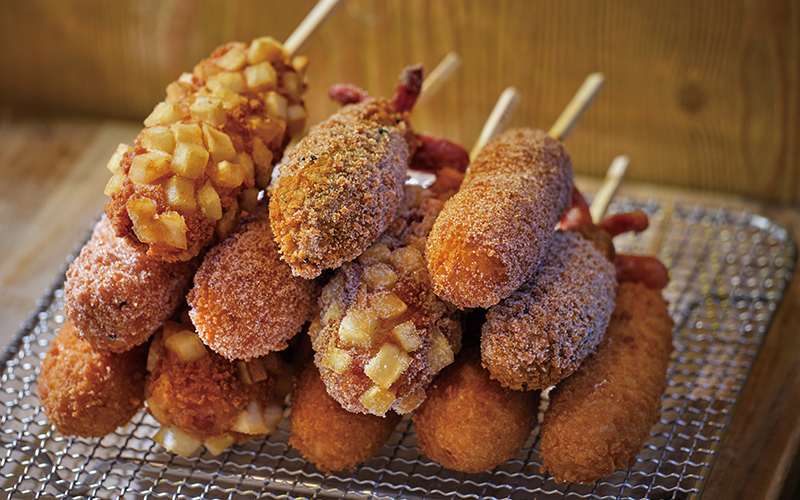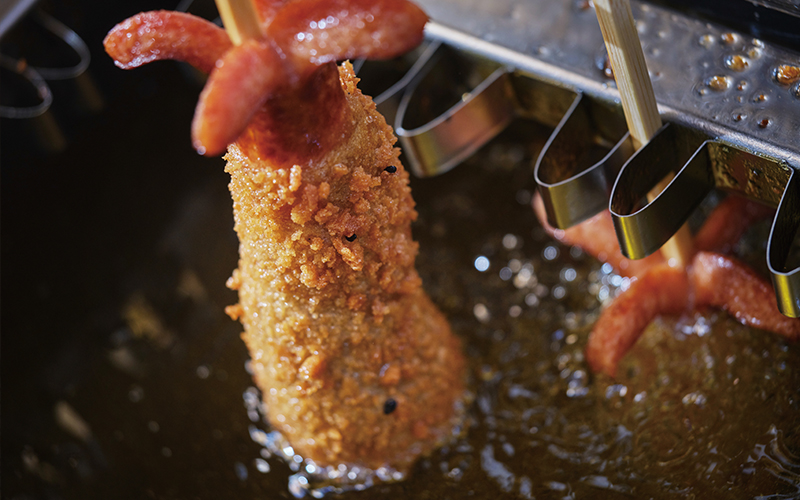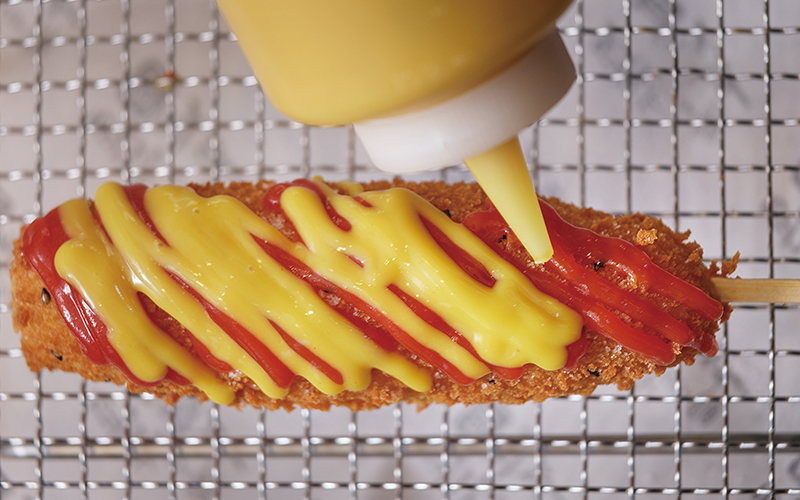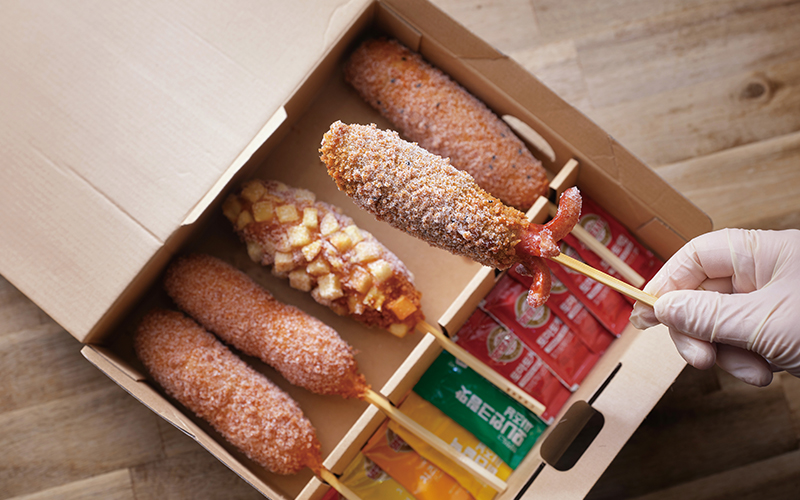- 한국어
- English
- 日本語
- 中文
- العربية
- Español
- Français
- Deutsch
- Pусский
- Tiếng Việt
- Indonesian
|
Snack section of Monthly KOREA’s March 2020 issue. ▶ Link to Webzine |
Corn Dogs
Corn dogs (called “hot dogs” in Korea) are believed to have arrived on Korea’s shores in the 1980s. Despite its longtime status as a street food here, a recent resurgence thanks to creative designs and concoctions has restored the popularity of corn dogs in the country. In addition, their growing presence abroad could make corn dogs the next major K-food export. Here is how the revamped food has established a niche spot in a dog-eat-dog market.
Written by Kim Jane / Photographed by Studio Kenn

A classic Korean corn dog consists of thickly battered and chewy dough with a sausage inside and is sprinkled with sugar and drizzled with ketchup and mustard. Today, this traditional snack is available with multiple condiments as well as crusts. The most famous type is dough battered with thickly chopped French fries and dates back to the 1990s. This version has several names: mandeukee (a doll popular in the 1960s), motnanee (ugly), gamja (potato), dokkebi (goblin) or simply yetnal (old-fashioned).
The plethora of corn dog versions in Korea offers an array of eclectic and unpredictable flavors. Mozzarella and cheddar cheese are the most common toppings, and garnishes range from fusion to traditional including kimchi, tteok (rice cake), ramen crust and squid ink. And for the more culinary adventurous, hearty supplements like bacon and shrimp can be wrapped around the sausage or dough crust, with breadcrumbs or peanut crumbs sprinkled for extra crunch.
Rather than offering a limited menu, certain stalls let customers create the dream corn dog of their choice. Colorful bottles of relish and condiments align the vendors’ makeshift countertops. These sauces are often rarities themselves in featuring the flavors of wasabi, fruit, and even full-fledged dishes like tteokbokki (spicy rice cake) and garlic chicken. Wilder combinations can be spotted on the streets of Myeong-dong, a tourist hotspot for Korea’s most popular street foods.

A corn dog can be made of not only sausage but also tteok (rice cake) and cheese.
Expansion of Turf
Since the 1980s — when corn dogs debuted on Korean streets — to present day, corn dog vendors have usually appealed to passersby in favoring transitional spaces at subway stations, in front of schools and rest stops instead of sites like sports stadiums and movie theaters. Throughout the 1980s and 90s, vendors without storefronts sold classic corn dogs. Although corn dogs still abound at makeshift stalls like those in Myeongdong, the revival of the food’s popularity in 2016 fueled a flurry of specialty franchises, usually in the form of minimal brick-and-mortar stores. Corn dog-focused franchises have thrived not only in Korea but even abroad. In neighboring Japan or faraway American cities, corn dogs have seen a renaissance as a K-street food export.
Corn dogs have even claimed a presence even on grocery aisles. Instant corn dogs and ingredients for use in simplified corn dog prep (e.g., batter and flavored sausages) appeal to corn dog junkies or the more health conscious (in the form of “gourmet” frozen or vegan versions). Thus corn dogs are no longer merely a street food staple.

A corn dog emerges crunchy and golden from a deep fryer.
Nowadays, corn dogs are offered as a side dish and can even serve as a savvy pairing for bunsik (traditional cheap eats whose name linguistically denotes flourbased food) items like tteokbokki. They are also combined with convenience-oriented and maximally spiced-up dishes like ramyeon (instant noodles) and its numerous packaged variations. Variants of bunsik products in delivery or packaged form are frequently featured by mukbang (food streaming) content producers on YouTube both at home and abroad. Corn dogs are among items that had been traditionally considered more as snacks until they each saw surging popularity as full meals through an assortment of combinations.
Dependable in Down Times
Koreans have every reason to be proud of their corn dogs like New Yorkers do of their beloved bagels. The battered and deep-fried street food version of a K-corn dog is one of the most popular in the country. Once the dough reaches optimal crunchiness, spicy, salty or sweet toppings await to complement the hearty mix, and the ease of taking a corn dog while on the go is another advantage.
Some attribute the influx of new corn dog franchises to Korea’s sluggish economy. Though snack options cannot sufficiently attest to the state of the consumer economy at large, Corn dog orders are mostly take out in Korea, making it an easy and cheap business to start for cash-strapped or rookie entrepreneurs. A Feb. 14 article by The Korea Bizwire said that despite the coronavirus outbreak, sales of corn dogs rose 33% as Koreans opted to stay away from places with crowds.

Toppings and flavoring, often mixed into combinations, can be tailored to personal taste.
In the latter half of the 2010s, Korean millennials faced lower job prospects as the unemployment rate skyrocketed. To set up a simple corn dog kiosk, however, requires neither fancy cooking skills nor spatial arrangement. This low overhead and hassle make such a kiosk an easy business to start amid the nationwide economic slump.
The creativity and variety of Koreanstyle corn dogs has seen the food’s popularity soar both at home and abroad, spurring many to consider K-corn dogs as the next big Hallyu export. Chung Chun Rice Dog is a New York-based chain of the specialty, while Myungrang Hot Dog started in Los Angeles’ Koreatown and has since opened branches in the U.S. states of Hawaii, Nevada, Georgia and Texas. K-corn dogs thus boast an array of dough, toppings and sauces that are sure to please hungry fans the world over.

The corn dog in Korea has seen a renaissance thanks to constant evolution.